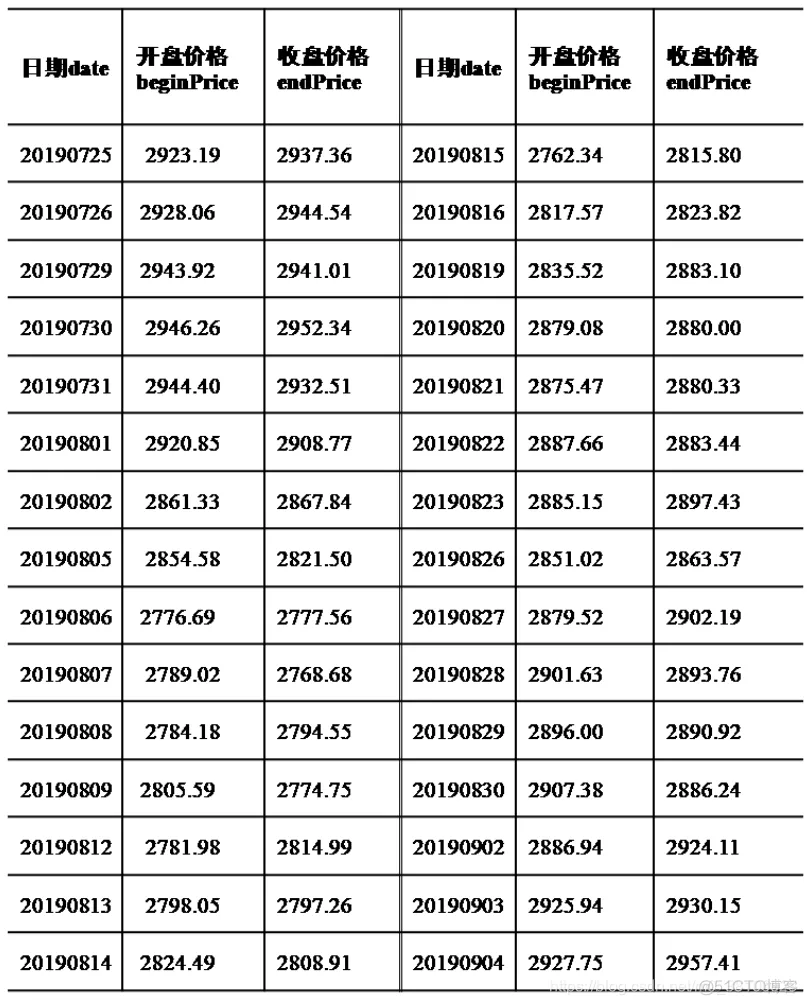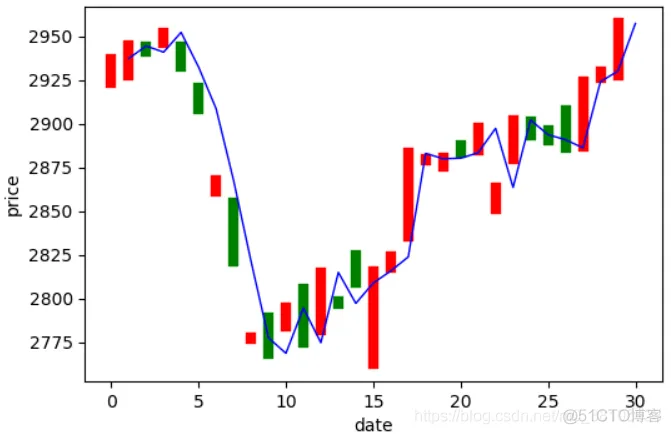产品
神经网络(NeuralNetworks)是一种用训练数据拟合目标函数的黑箱模型,只要数据量足够大,它可以拟合出输入到输出之间的任意函数关系。
本篇博文将使用TensorFlow神经网络进行股市的预测,利用数据样本学习,得到相关因素预测股票走势。
首先预设一组数据,下图为股票上证指数2019年07月到2019年09月的30天开盘价格和收盘价格。

数据在程序中实现,代码如下所示:
date = np.linspace(1,30,30)beginPrice = np.array([2923.19,2928.06,2943.92,2946.26,2944.40,2920.85,
2861.33,2854.58,2776.69,2789.02, 2784.18,2805.59,2781.98,2798.05,2824.49,2762.
34,2817.57,2835.52,2879.08,2875.47, 2887.66,2885.15,2851.02,2879.52,2901.63,2896.
00,2907.38,2886.94,2925.94,2927.75])endPrice = np.array([2937.36,2944.54,2941.01,2952.34,2932.51,2908.77,
2867.84,2821.50,2777.56,2768.68, 2794.55,2774.75,2814.99,2797.26,2808.91,2815.80,2823.
82,2883.10,2880.00,2880.33, 2883.44,2897.43,2863.57,2902.19,2893.76,2890.92,2886.24,
2924.11,2930.15,2957.41])1.2.3.4.5.6.7.基于matplotlib可视化库,建立一个30行2列的矩阵存储股票数据,矩阵的第一列输入上列数据中的股票开盘价格,第二列输入股票的收盘价格,如果股票的收盘价格高于开盘价格则用红色显示,反之则用绿色显示,可视化股票数据如下图所示。采用本实例所设计的神经网络预测股票收盘均价,并可视化预测结果。

使用前需要安装matplotlib模块,指令如下所示:
pip install matplotlib1.实现代码如下所示:
for i in range(0,30): # 画柱状图 dateOne = np.zeros([2]) dateOne[0] = i;
dateOne[1] = i; priceOne = np.zeros([2]) priceOne[0] = beginPrice[i]
priceOne[1] = endPrice[i] if endPrice[i]>beginPrice[i]:
plt.plot(dateOne,priceOne,'r',lw=6) else:
plt.plot(dateOne,priceOne,'g',lw=6)plt.xlabel("date")plt.ylabel("price")1.2.3.4.5.6.7.8.9.10.11.12.13.基于TensorFlow框架,设计三层神经网络,隐含层包括25个节点,利用所设计的神经网络来预测股票的收盘均价。使用前需要安装TensorFlow模块,指令如下所示:
pip install tensorflow1.【拓展】4行指令解决pip下载Python第三方库太慢问题(pip更换国内下载源)
实现代码如下所示:
dateNormal = np.zeros([30,1])priceNormal = np.zeros([30,1])#归一化for i in range(0,30):
dateNormal[i,0] = i/29.0; priceNormal[i,0] = endPrice[i]/3000.0;x = tf
.placeholder(tf.float32,[None,1])y = tf.placeholder(tf.float32,[None,1])
# X->hidden_layerw1 = tf.Variable(tf.random_uniform([1,25],0,1))b1 = tf.Variable(tf.zeros([1,25]))wb1 = tf
.matmul(x,w1)+b1layer1 = tf.nn.relu(wb1) # 激励函数# hidden_layer->outputw2 = tf
.Variable(tf.random_uniform([25,1],0,1))b2 = tf.Variable(tf.zeros([30,1]))wb2 = tf
.matmul(layer1,w2)+b2layer2 = tf.nn.relu(wb2)loss = tf.reduce_mean(tf.square(y-layer2))
#y为真实数据, layer2为网络预测结果 #梯度下降train_step = tf.train.GradientDescentOptimizer(0.1)
.minimize(loss)with tf.Session() as sess: sess.run(tf.global_variables_initializer())
for i in range(0,20000): sess.run(train_step,feed_dict={x:dateNormal,y:priceNormal})
#预测, X w1w2 b1b2 -->layer2 pred = sess.run(layer2,feed_dict={x:dateNormal})
predPrice = np.zeros([30,1]) for i in range(0,30): predPrice[i,0]=(pred*3000)[i,0]
plt.plot(date,predPrice,'b',lw=1)plt.show()1.2.3.4.5.6.7.8.9.10.11.12.13.14.15.16.17.18.19.20.21.
22.23.24.25.26.27.28.29.30.31.32.运行以上代码可视化神经网络的预测结果如下图所示:

免责声明:本文系网络转载或改编,未找到原创作者,版权归原作者所有。如涉及版权,请联系删